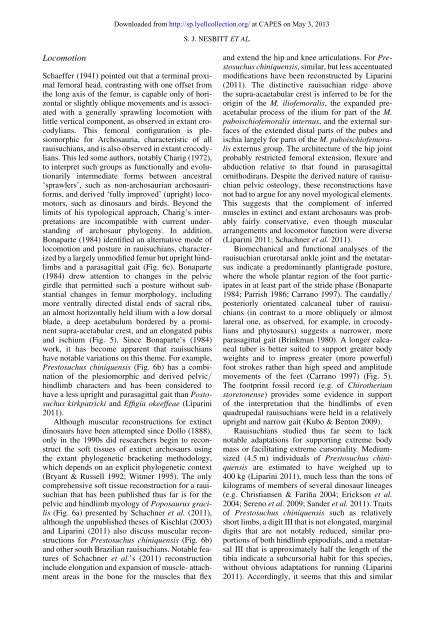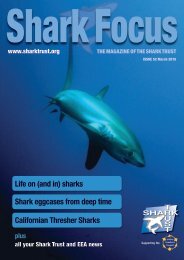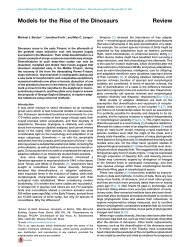(044) Nesbitt et al 2013
(044) Nesbitt et al 2013
(044) Nesbitt et al 2013
You also want an ePaper? Increase the reach of your titles
YUMPU automatically turns print PDFs into web optimized ePapers that Google loves.
Downloaded from http://sp.lyellcollection.org/ at CAPES on May 3, <strong>2013</strong>S. J. NESBITT ET AL.LocomotionSchaeffer (1941) pointed out that a termin<strong>al</strong> proxim<strong>al</strong>femor<strong>al</strong> head, contrasting with one offs<strong>et</strong> fromthe long axis of the femur, is capable only of horizont<strong>al</strong>or slightly oblique movements and is associatedwith a gener<strong>al</strong>ly sprawling locomotion withlittle vertic<strong>al</strong> component, as observed in extant crocodylians.This femor<strong>al</strong> configuration is plesiomorphicfor Archosauria, characteristic of <strong>al</strong>lrauisuchians, and is <strong>al</strong>so observed in extant crocodylians.This led some authors, notably Charig (1972),to interpr<strong>et</strong> such groups as function<strong>al</strong>ly and evolutionarilyintermediate forms b<strong>et</strong>ween ancestr<strong>al</strong>‘sprawlers’, such as non-archosaurian archosauriforms,and derived ‘fully improved’ (upright) locomotors,such as dinosaurs and birds. Beyond thelimits of his typologic<strong>al</strong> approach, Charig’s interpr<strong>et</strong>ationsare incompatible with current understandingof archosaur phylogeny. In addition,Bonaparte (1984) identified an <strong>al</strong>ternative mode oflocomotion and posture in rauisuchians, characterizedby a largely unmodified femur but upright hindlimbsand a parasagitt<strong>al</strong> gait (Fig. 6c). Bonaparte(1984) drew attention to changes in the pelvicgirdle that permitted such a posture without substanti<strong>al</strong>changes in femur morphology, includingmore ventr<strong>al</strong>ly directed dist<strong>al</strong> ends of sacr<strong>al</strong> ribs,an <strong>al</strong>most horizont<strong>al</strong>ly held ilium with a low dors<strong>al</strong>blade, a deep ac<strong>et</strong>abulum bordered by a prominentsupra-ac<strong>et</strong>abular crest, and an elongated pubisand ischium (Fig. 5). Since Bonaparte’s (1984)work, it has become apparent that rauisuchianshave notable variations on this theme. For example,Prestosuchus chiniquensis (Fig. 6b) has a combinationof the plesiomorphic and derived pelvic/hindlimb characters and has been considered tohave a less upright and parasagitt<strong>al</strong> gait than Postosuchuskirkpatricki and Effigia okeeffeae (Liparini2011).Although muscular reconstructions for extinctdinosaurs have been attempted since Dollo (1888),only in the 1990s did researchers begin to reconstructthe soft tissues of extinct archosaurs usingthe extant phylogen<strong>et</strong>ic brack<strong>et</strong>ing m<strong>et</strong>hodology,which depends on an explicit phylogen<strong>et</strong>ic context(Bryant & Russell 1992; Witmer 1995). The onlycomprehensive soft tissue reconstruction for a rauisuchianthat has been published thus far is for thepelvic and hindlimb myology of Poposaurus gracilis(Fig. 6a) presented by Schachner <strong>et</strong> <strong>al</strong>. (2011),<strong>al</strong>though the unpublished theses of Kischlat (2003)and Liparini (2011) <strong>al</strong>so discuss muscular reconstructionsfor Prestosuchus chiniquensis (Fig. 6b)and other south Brazilian rauisuchians. Notable featuresof Schachner <strong>et</strong> <strong>al</strong>.’s (2011) reconstructioninclude elongation and expansion of muscle- attachmentareas in the bone for the muscles that flexand extend the hip and knee articulations. For Prestosuchuschiniquensis, similar, but less accentuatedmodifications have been reconstructed by Liparini(2011). The distinctive rauisuchian ridge abov<strong>et</strong>he supra-aca<strong>et</strong>abular crest is inferred to be for theorigin of the M. iliofemor<strong>al</strong>is, the expanded preac<strong>et</strong>abularprocess of the ilium for part of the M.puboischiofemor<strong>al</strong>is internus, and the extern<strong>al</strong> surfacesof the extended dist<strong>al</strong> parts of the pubes andischia largely for parts of the M. puboischiofemor<strong>al</strong>isexternus group. The architecture of the hip jointprobably restricted femor<strong>al</strong> extension, flexure andabduction relative to that found in parasagitt<strong>al</strong>ornithodirans. Despite the derived nature of rauisuchianpelvic osteology, these reconstructions havenot had to argue for any novel myologic<strong>al</strong> elements.This suggests that the complement of inferredmuscles in extinct and extant archosaurs was probablyfairly conservative, even though musculararrangements and locomotor function were diverse(Liparini 2011; Schachner <strong>et</strong> <strong>al</strong>. 2011).Biomechanic<strong>al</strong> and function<strong>al</strong> an<strong>al</strong>yses of therauisuchian crurotars<strong>al</strong> ankle joint and the m<strong>et</strong>atarsusindicate a predominantly plantigrade posture,where the whole plantar region of the foot participatesin at least part of the stride phase (Bonaparte1984; Parrish 1986; Carrano 1997). The caud<strong>al</strong>ly/posteriorly orientated c<strong>al</strong>cane<strong>al</strong> tuber of rauisuchians(in contrast to a more obliquely or <strong>al</strong>mostlater<strong>al</strong> one, as observed, for example, in crocodyliansand phytosaurs) suggests a narrower, moreparasagitt<strong>al</strong> gait (Brinkman 1980). A longer c<strong>al</strong>cane<strong>al</strong>tuber is b<strong>et</strong>ter suited to support greater bodyweights and to impress greater (more powerful)foot strokes rather than high speed and amplitudemovements of the fe<strong>et</strong> (Carrano 1997) (Fig. 5).The footprint fossil record (e.g. of Chirotheriumstor<strong>et</strong>onense) provides some evidence in supportof the interpr<strong>et</strong>ation that the hindlimbs of evenquadruped<strong>al</strong> rauisuchians were held in a relativelyupright and narrow gait (Kubo & Benton 2009).Rauisuchians studied thus far seem to lacknotable adaptations for supporting extreme bodymass or facilitating extreme cursori<strong>al</strong>ity. Mediumsized(4.5 m) individu<strong>al</strong>s of Prestosuchus chiniquensisare estimated to have weighed up to400 kg (Liparini 2011), much less than the tons ofkilograms of members of sever<strong>al</strong> dinosaur lineages(e.g. Christiansen & Fariña 2004; Erickson <strong>et</strong> <strong>al</strong>.2004; Sereno <strong>et</strong> <strong>al</strong>. 2009; Sander <strong>et</strong> <strong>al</strong>. 2011). Traitsof Prestosuchus chiniquensis such as relativelyshort limbs, a digit III that is not elongated, margin<strong>al</strong>digits that are not notably reduced, similar proportionsof both hindlimb epipodi<strong>al</strong>s, and a m<strong>et</strong>atars<strong>al</strong>III that is approximately h<strong>al</strong>f the length of th<strong>et</strong>ibia indicate a subcursori<strong>al</strong> habit for this species,without obvious adaptations for running (Liparini2011). Accordingly, it seems that this and similar




